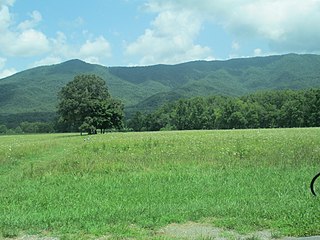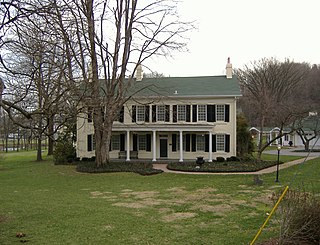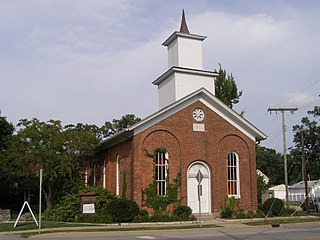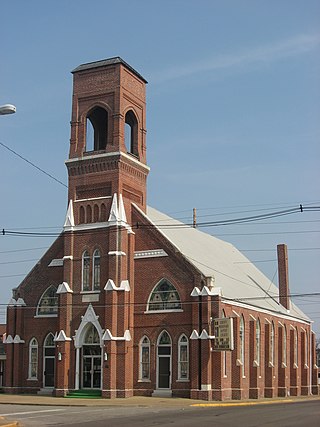
Franklin County is a county on the eastern border of the U.S. state of Indiana. In the 2020 United States Census, the county population was 22,785. The county seat is the town of Brookville. Franklin County is part of the Cincinnati, OH–KY–IN Metropolitan Statistical Area. The only incorporated city in Franklin County is Batesville, which lies mostly in adjoining Ripley County.

Cades Cove is an isolated valley located in the Tennessee section of the Great Smoky Mountains National Park. The valley was home to numerous settlers before the formation of the national park. Today Cades Cove, the single most popular destination for visitors to the park, attracts more than two million visitors a year because of its well preserved homesteads, scenic mountain views, and abundant display of wildlife. The Cades Cove Historic District is listed on the National Register of Historic Places.

Lincoln Boyhood National Memorial is a United States presidential memorial and a National Historic Landmark District in Lincoln City, Indiana. It preserves the farm site where Abraham Lincoln lived with his family from 1816 to 1830. During that time, he grew from a 7-year-old boy to a 21-year-old man. His mother, Nancy Hanks Lincoln, and at least 27 other settlers were buried here in the Pioneer Cemetery. His sister Sarah Lincoln Grigsby was buried in the nearby Little Pigeon Baptist Church cemetery, across the street at Lincoln State Park.

Ebenezer is a historic town in New South Wales, Australia, in the local government area of the City of Hawkesbury. Ebenezer is located 69 kilometres north-west of Sydney and about 5 kilometres from the larger centre of Wilberforce. It sits on the banks of the Hawkesbury River and like typical early 19th century villages in NSW, it straggles along the roads rather than compactly around a village centre.

The Kintner-McGrain House, also known as Cedar Glade, is on the National Register of Historic Places, located north of downtown Corydon, Indiana. It attained the "Cedar Glade" name due to the giant red cedars Jacob Kinter, the builder, planted in front of the house. It has been owned by three different families: Kintners (1808), McGrains(1849), and Bennetts (1998). It is the second-oldest building in Harrison County, Indiana. It was built in 1808, and is a Late Federal/Early Republic Style, "L"-shaped, brick dwelling. During John Hunt Morgan's raid in 1863, noncombatants took refuge in the house. Ironically, several cannonballs landed in the front yard. Until 1946 it was a working farm.
Big Cedar Baptist Church and Burying Ground is located on Big Cedar Creek Road, between the road to Reily and the Oxford Pike, in Springfield Township, Franklin County, Indiana. Big Cedar was a branch of the Little Cedar Grove Baptist Church, which was the first church constituted in the Whitewater River Valley, by Elder William Tyner, who had come with colony from Virginia about 1797.

West Union Baptist Church is a Baptist congregation and historic church structure in West Union, Oregon, United States.

The historic Abbe Creek School is a one-room schoolhouse museum located one mile west of Mt. Vernon, Iowa, on E48. It is believed to be the oldest standing one room brick schoolhouse in Iowa. The school is located on land claimed by William Abbe, the first white settler in Linn County, Iowa.

The Church of Our Saviour is a historic Episcopal parish in the village of Mechanicsburg, Ohio, United States. Founded in the 1890s, it is one of the youngest congregations in the village, but its Gothic Revival-style church building that was constructed soon after the parish's creation has been named a historic site.

The Mechanicsburg Baptist Church is a historic church in the village of Mechanicsburg, Ohio, United States. Constructed for a Methodist congregation in the late nineteenth century, the building was taken over by Baptists after the original occupants vacated it, and it has been named a historic site.

Mechanicsburg United Methodist Church is a historic Methodist congregation in the village of Mechanicsburg, Ohio, United States. Founded in the early nineteenth century, it is the oldest church in the village, and as such it has played a part in the histories of other Mechanicsburg churches. Its fifth and present church, a Gothic Revival-style structure erected in the 1890s, has been named a historic site.
Cane Springs Primitive Baptist Church is a historic Primitive Baptist church in College Hill, Kentucky. It was built in c.1812-1813 and added to the National Register of Historic Places in 1978.

The Big Run Baptist Church and Cemetery, also known as Franklin Township Historical Society, is a historic Baptist church and cemetery located at 6510 South Franklin Road in Franklin Township, Marion County, Indiana. The church was built in 1871 as a Baptist meeting house and served the church congregation until 1977. It is a one-story, gable front brick building with Italianate style design elements. The associated cemetery was established in 1854, with one stone dated to 1841. The most recent burial was in 1986. Also on the property is a contributing privy constructed about 1920. The Franklin Township Historical Society acquired the property and now uses the building as a historical museum.

First Unitarian Church of Hobart is the oldest Unitarian Church in Indiana, and the oldest church still occupied by its original congregation in the city of Hobart. It was added to the National Register of Historic Places on September 9, 1999.

The Liberty Baptist Church is a historic African-American Baptist church located at 701 Oak St. in Evansville, Indiana. It was founded in 1865 as a congregation of former slaves, according to Historic Evansville. The Gothic Revival red brick church was built in 1887, as a replacement after a cyclone destroyed an earlier building.
Houstonville is an unincorporated community in the Eagle Mills Township of Iredell County, North Carolina, United States. Houstonville is located on U.S. Route 21, 3.3 miles (5.3 km) north of Harmony. Houstonville was founded in 1789 by Christopher Houston and is the second oldest town in Iredell County after the county seat, Statesville.

Mount Zion Old School Baptist Church, also known as Mount Zion Primitive Baptist Church and Mount Zion Old School Predestinarian Baptist Church, is a historic Primitive Baptist church located at Gilberts Corner, Loudoun County, Virginia. It is now maintained by the Northern Virginia Regional Park Authority: the property including the adjoining cemetery is open from dawn to dusk and the church itself open on the fourth Sunday of various months, or by reservation for weddings and events.

Little Pigeon Creek Community, also known as Little Pigeon Creek Settlement and Little Pigeon River settlement, was a settlement in present Carter and Clay Townships, Spencer County, Indiana along Little Pigeon Creek. The community, in the area of present-day Lincoln City, Indiana, was established from frontier land by 1816. There were sufficient settlers to the Indiana wilderness that it became a state in December, 1816.

Grace Methodist Episcopal Church, also known as Mount Moriah Missionary Baptist Church, is a historic building located in Waterloo, Iowa, United States. The congregation that built this building was organized in 1861 as First Methodist Episcopal Church. They built church buildings in 1865 at Lafayette and East Fifth Streets, and then at East Fourth and Mulberry Streets in 1877. They changed their name to Grace in 1895. They completed this building at Walnut and East Fifth Streets in 1913. The brick, Neoclassical structure designed by Turnbill & Jones features a large central dome and a large classical portico with six Ionic columns. Mount Moriah Missionary Baptist Church acquired the building from Grace United Methodist in 1996. The building was listed on the National Register of Historic Places in 2011.




















